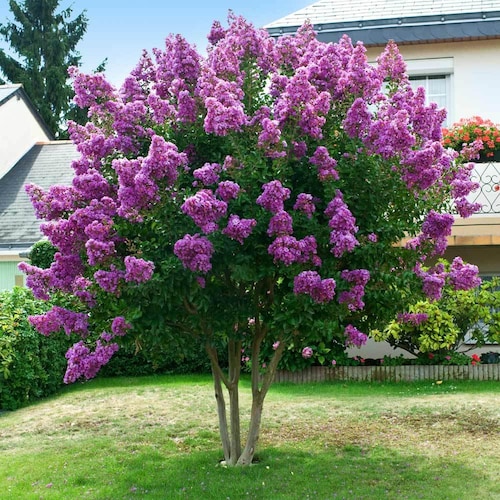The Story of Purple Crepe Myrtle
A Legacy Rooted in Time
The Purple Crepe Myrtle tree has experienced an ornamental evolution that extends over several centuries. Lush Asian landscapes in China, Korea, and Japan were the birthplace of this species. European explorers first documented it in the 18th century when botanical expeditions brought it to the Western world because of its impressive beauty and adaptability. Horticulturists and gardeners rapidly adopted it because of its breathtaking flowers, unique peeling bark texture, and exceptional ability to withstand harsh conditions.
André Michaux the renowned botanist introduced the plant to North America in the late 1700s by bringing it to Charleston, South Carolina. The plant became a Southern garden staple because it thrives in warm climates while resisting drought and maintaining a long-lasting floral display. Selective breeding improved the plant's color diversity along with increasing its resistance to disease and adaptability to different soil types.
Purple Crepe Myrtle Medicinal and Practical Uses
This species serves both as an ornamental beauty and a traditional medical resource. Leaves and bark were prepared into teas or used as topical applications in certain cultures to relieve minor wounds and skin inflammation. The plant contains extracts that demonstrated antibacterial properties and were historically used for treating mild infections. Its astringent properties make it valuable as a traditional herbal remedy which supports digestive health and improves skin condition.
Recent scientific investigations into its compounds demonstrate the presence of antioxidants and anti-inflammatory elements that show promise for advancing medical research. Although today, herbal medicine rarely includes it as a primary element, historical records demonstrate its multifaceted nature and the advanced understanding of early practitioners who valued natural remedies.
Enhancing Landscapes Across the Globe
Purple Crepe Myrtle serves as an essential component in urban and residential landscapes because it thrives across different conditions while delivering extraordinary visual beauty. This plant combines aesthetic appeal with functional use across different settings like historic city streets and both botanical gardens and suburban neighborhoods. Landscapers and homeowners love this plant because it withstands high temperatures, repels pests and requires little maintenance.
Many designers use this plant as part of their landscape arrangements to establish attractive focal points and maintain continuous visual interest throughout the year. The tree's delicate flowers form extended clusters but its distinct peeling bark provides texture to landscapes throughout dormant periods. The tree displays flexibility by functioning in multiple landscapes whether lining walkways, standing alone in gardens, or outlining fences.
The Purple Crepe Myrtle Offers Stunning Visual Interest
The tree offers a stunning visual experience that constantly holds onlookers' attention with its dynamic display. The tree displays a lush green canopy of leaves during the growing season which provides a stunning contrast to the vibrant flower clusters that appear in late spring and continue flowering through summer. The blossoms of crinkled delicate petals generate a tender romantic visual effect while they flow like colorful clouds.

The arrival of autumn brings an enchanting transformation in the tree's foliage which bursts into fiery reds, deep oranges, and golden colors ensuring it stays visually stunning past its flowering season. During winter months this tree displays its unique bark which peels off in thin smooth sheets that reveal patterns of cinnamon gray and cream colors giving its structure a sculptural appearance.
Both gardeners and city planners favor this plant because its dynamic presence in landscape settings delivers visual interest across multiple seasons. No other ornamental tree combines both floral beauty and vibrant autumn colors with winter interest.
A Haven for Rare and Unique Wildlife
Purple Crepe Myrtle delivers visual interest while functioning as a critical habitat that provides food and shelter to diverse wildlife species. Its nectar-rich blossoms attract bees and butterflies and make this plant crucial for gardens aiming to support biodiversity. The presence of monarch butterflies contributes to the tree's enchanting charm and creates a magical scene when their delicate wings come into view.
Birds frequent the branches during cooler months because seed capsules replace the blooms to provide essential food. The seeds become a food for finches and small songbirds during periods when natural food supplies diminish. The tree's dense branching pattern serves as a protective nesting refuge for birds against predators and extreme weather.
The tree's flowers draw moths, which then attract nocturnal birds and bats to its canopy, forming a small ecosystem. These creatures demonstrate how this tree helps preserve environmental stability while remaining an essential feature of wildlife-friendly landscapes.
Purple Crepe Myrtle: An Unmatched Garden Gem
Purple Crepe Myrtle stands above most plants in terms of both its impressive appearance and its durable nature. The combination of its historical depth and cultural meaning with its beautiful appearance makes this tree a valued component of gardens and streetscapes all over the world. Gardeners alongside landscape designers and nature enthusiasts appreciate this plant for its enduring flowers as well as its traditional medicinal properties and ability to draw rare wildlife.
This tree expresses its enduring strength and environmental compatibility through a narrative of beauty and resilience with each passing season. The combination of its vibrant colors together with its fragile blossoms and unique bark results in its status as a cherished landscape element across the world. The tree will maintain its heritage of beauty and usefulness in gardens throughout succeeding generations.